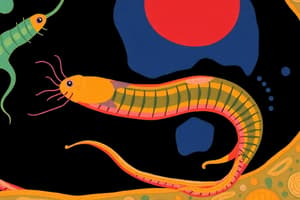Podcast
Questions and Answers
What treatment should be given to correct anemia caused by hookworms?
What treatment should be given to correct anemia caused by hookworms?
- Iron and vitamins only
- High protein diet only
- Blood transfusion only
- Iron, vitamins, and high protein diet (correct)
Which of the following is the infective stage for Taenia saginata?
Which of the following is the infective stage for Taenia saginata?
- Cysticercus bovis (correct)
- Cysticercus cellulosae
- Gravid segments
- Ova
What is the primary medication of choice for treating Taenia saginata infection?
What is the primary medication of choice for treating Taenia saginata infection?
- Praziquantel (correct)
- Ivermectin
- Mebendazole
- Albendazole
How do humans typically acquire Echinococcus granulosus infection?
How do humans typically acquire Echinococcus granulosus infection?
What is the recommended treatment for unilocular cysts of Echinococcus granulosus when surgery is possible?
What is the recommended treatment for unilocular cysts of Echinococcus granulosus when surgery is possible?
In terms of transmission, how does Hymenolepis nana spread?
In terms of transmission, how does Hymenolepis nana spread?
What procedure is performed when surgery is impossible for hydatid cyst treatment?
What procedure is performed when surgery is impossible for hydatid cyst treatment?
Which medication should be avoided in the treatment of Taenia solium?
Which medication should be avoided in the treatment of Taenia solium?
What is the infective stage of Fasciola hepatica?
What is the infective stage of Fasciola hepatica?
Which mode of transmission is associated with Heterophyes heterophyes?
Which mode of transmission is associated with Heterophyes heterophyes?
What is considered the drug of choice for treating Schistosoma infections?
What is considered the drug of choice for treating Schistosoma infections?
When is the infective stage for Trichuris trichura reached?
When is the infective stage for Trichuris trichura reached?
What is the primary mode of transmission for Wuchereia bancrofti?
What is the primary mode of transmission for Wuchereia bancrofti?
Which treatment is primarily recommended for Trichuris trichura infections?
Which treatment is primarily recommended for Trichuris trichura infections?
What is the infective stage of Strongyloides stercoralis?
What is the infective stage of Strongyloides stercoralis?
What is the primary treatment for infections caused by Fasciola hepatica?
What is the primary treatment for infections caused by Fasciola hepatica?
What is the infective stage of Entamoeba histolytica?
What is the infective stage of Entamoeba histolytica?
What is the drug of choice for treating symptomatic intestinal disease caused by Entamoeba histolytica?
What is the drug of choice for treating symptomatic intestinal disease caused by Entamoeba histolytica?
Which protozoan infection is transmitted via contaminated food and water through the feco-oral route and requires metronidazole for treatment?
Which protozoan infection is transmitted via contaminated food and water through the feco-oral route and requires metronidazole for treatment?
How is Balantidium coli primarily transmitted?
How is Balantidium coli primarily transmitted?
Which treatment is indicated for luminal infections caused by Entamoeba histolytica?
Which treatment is indicated for luminal infections caused by Entamoeba histolytica?
What is the mode of infection for Trypanosoma gambiense?
What is the mode of infection for Trypanosoma gambiense?
Which protozoan has a mature cyst as its infective stage and is treated with metronidazole?
Which protozoan has a mature cyst as its infective stage and is treated with metronidazole?
What alternative medication follows metronidazole for treating symptomatic intestinal infections of Entamoeba histolytica?
What alternative medication follows metronidazole for treating symptomatic intestinal infections of Entamoeba histolytica?
What is the primary treatment for Ascariasis caused by Ascaris lumbricoides?
What is the primary treatment for Ascariasis caused by Ascaris lumbricoides?
Which mode of infection is NOT associated with Enterobius vermicularis?
Which mode of infection is NOT associated with Enterobius vermicularis?
What is the primary infective stage of Trichinella spiralis?
What is the primary infective stage of Trichinella spiralis?
Which treatment is effective against Enterobius vermicularis and helps relieve associated itching?
Which treatment is effective against Enterobius vermicularis and helps relieve associated itching?
How does Ancylostoma duodenale primarily infect humans?
How does Ancylostoma duodenale primarily infect humans?
What is the primary infective stage for Ascaris lumbricoides?
What is the primary infective stage for Ascaris lumbricoides?
What is a common means of mechanical transmission for Ascaris lumbricoides?
What is a common means of mechanical transmission for Ascaris lumbricoides?
Which of the following is NOT true concerning the treatment of pinworms?
Which of the following is NOT true concerning the treatment of pinworms?
Flashcards
Infective stage
Infective stage
The stage of a parasite that is capable of infecting a new host.
Mode of Transmission
Mode of Transmission
The way a parasite is transmitted from one host to another.
Treatment
Treatment
A medication used to kill or control parasites within the body.
Fasciola hepatica
Fasciola hepatica
Signup and view all the flashcards
Fasciola hepatica: Infective Stage
Fasciola hepatica: Infective Stage
Signup and view all the flashcards
Fasciola hepatica: Mode of Transmission
Fasciola hepatica: Mode of Transmission
Signup and view all the flashcards
Praziquantel
Praziquantel
Signup and view all the flashcards
Trichuris trichura
Trichuris trichura
Signup and view all the flashcards
Ascaris lumbricoides
Ascaris lumbricoides
Signup and view all the flashcards
Infective stage of Ascaris lumbricoides
Infective stage of Ascaris lumbricoides
Signup and view all the flashcards
Mode of infection: Ascaris lumbricoides
Mode of infection: Ascaris lumbricoides
Signup and view all the flashcards
Enterobius vermicularis
Enterobius vermicularis
Signup and view all the flashcards
Infective stage of Enterobius vermicularis
Infective stage of Enterobius vermicularis
Signup and view all the flashcards
Mode of infection: Enterobius vermicularis
Mode of infection: Enterobius vermicularis
Signup and view all the flashcards
Trichinella spiralis
Trichinella spiralis
Signup and view all the flashcards
Infective stage of Trichinella spiralis
Infective stage of Trichinella spiralis
Signup and view all the flashcards
Delayed Hemoglobin Recovery
Delayed Hemoglobin Recovery
Signup and view all the flashcards
Cysticercus
Cysticercus
Signup and view all the flashcards
Taenia solium
Taenia solium
Signup and view all the flashcards
Taenia saginata
Taenia saginata
Signup and view all the flashcards
Cysticercus bovis
Cysticercus bovis
Signup and view all the flashcards
Cysticercus cellulosae
Cysticercus cellulosae
Signup and view all the flashcards
Echinococcus granulosus
Echinococcus granulosus
Signup and view all the flashcards
Hydatid cyst
Hydatid cyst
Signup and view all the flashcards
Entamoeba histolytica: Infective Stage
Entamoeba histolytica: Infective Stage
Signup and view all the flashcards
Entamoeba histolytica: Mode of Transmission
Entamoeba histolytica: Mode of Transmission
Signup and view all the flashcards
Entamoeba histolytica: Treatment
Entamoeba histolytica: Treatment
Signup and view all the flashcards
Balantidium coli: Infective Stage
Balantidium coli: Infective Stage
Signup and view all the flashcards
Balantidium coli: Mode of Transmission
Balantidium coli: Mode of Transmission
Signup and view all the flashcards
Balantidium coli: Treatment
Balantidium coli: Treatment
Signup and view all the flashcards
Giardia intestinalis: Infective Stage
Giardia intestinalis: Infective Stage
Signup and view all the flashcards
Giardia intestinalis: Mode of Transmission
Giardia intestinalis: Mode of Transmission
Signup and view all the flashcards
Giardia intestinalis: Treatment
Giardia intestinalis: Treatment
Signup and view all the flashcards
Trypanosoma gambiense: Infective Stage
Trypanosoma gambiense: Infective Stage
Signup and view all the flashcards
Trypanosoma gambiense: Mode of Transmission
Trypanosoma gambiense: Mode of Transmission
Signup and view all the flashcards
Trypanosoma gambiense: Treatment
Trypanosoma gambiense: Treatment
Signup and view all the flashcards
Study Notes
Parasitology Revision
- Parasitology revision covers identification, infective stages, transmission, and treatment.
- Genus is capitalized, species is lowercase.
- Diagnostic stages are also included.
Trematodes
- Trematodes are a type of parasitic flatworm.
- Fasciola species, such as Fasciola hepatica and Fasciola gigantica, are discussed, including their ova, larva, and adult forms. Key differentiators include size and prominence of shoulders.
Fasciola hepatica
- Infective stage: Metacercariae
- Mode of infection: Ingestion of aquatic plants, raw vegetables, watercress containing encysted metacercariae, drinking water with encysted metacercariae, or ingestion of raw liver from infected animals.
- Treatment: Triclabendazole (dose 10mg/kg body weight), Bitinol (30mg/kg for 5-10 days), Praziquantel is less effective.
Heterophyes heterophyes
- Infective stage: Metacercariae
- Mode of transmission: Ingesting undercooked or low-salt fish containing metacercariae
- Treatment: Praziquantel
Schistosoma
- Infective stage: Forked tail cercaria
- Mode of transmission: Skin penetration by forked tail cercaria when contacted with contaminated water
- Treatment: Praziquantel
Nematodes
- Trichuris trichura (whipworm)
- Infective stage: Eggs containing first-stage larvae
- Mode of transmission: Fecal-oral, consuming food or water contaminated with eggs.
- Treatment: Mebendazole, Albendazole, Iron supplements (if anemia)
Wuchereria bancrofti
- Infective stage: Filariform larvae
- Mode of transmission: Bite of infected female anopheles mosquitoes
- Treatment: Antibacterial cream on wound, Diethylcarbamazine, Ivermectine, Albendazole
Strongyloides stercolaris
- Infective stage: Filariform larvae
- Mode of transmission: Filariform larvae penetrate the intact skin, autoinfection (internal/external).
- Treatment: Ivermectin with albendazole
Ascaris lumbricoides
- Infective stage: Eggs containing second-stage rhabditiform larvae
- Mode of transmission: Ingesting mature eggs from contaminated food (green vegetables), water, or hands, house flies carrying eggs to food
- Treatment: Albendazole and mebendazole
Enterobius vermicularis
- Infective stage: Embryonated eggs
- Mode of transmission: Ingestion of eggs through contaminated food or drink, autoinfection, retro-infection, air borne, contact
- Treatment: Mebendazole, Pyrantel pamoate (initial dose, second dose in 2 weeks). Local treatment like mercurial ointments.
Trichinella spiralis
- Infective stage: Trichinella encysted (larva)
- Mode of transmission: Eating raw or undercooked pork containing infective encysted larvae
- Treatment: Albendazole, Mebendazole
Ancylostoma duodenale
- Infective stage: Infective filariform larva
- Mode of transmission: Penetrates intact skin, oral, transmammary/transplacental
- Treatment: Albendazole, Pyrantel, Mebendazole, Iron/vitamin/protein supplementation
Cestodes
-
Taenia (solium and saginata)
-
Infective stage: Cysticercus (solium, bovis); gravid segments
-
Mode of transmission: Saginata: Eating undercooked beef containing cysticercus bovis. Solium: Eating undercooked pork containing cysticercus cellulosae
-
Treatment: Saginata: Niclosamide, Praziquantel. Solium: Praziquantel (Niclosamide avoided)
Echinococcus granulosus
- Infective stage: Hydatid cyst
- Mode of transmission: Dogs and herbivores ingest hydatid cysts. Humans ingest eggs from contaminated food/vegetables
- Treatment: Surgery, mebendazole (pre-op), sterilization of fluid in cysts (formalin).
Hymenolepis nana
- Infective stage: Embryonated eggs
- Mode of transmission: Direct/indirect contact with infected host, autoinfection (internal/external), contamination with food or water, carried under nails
- Treatment: Praziquantel
Protozoa
- Entamoeba histolytica
- Infective stage: Entamoeba histolytica mature cyst
- Mode of transmission: Fecal-oral route (contaminated food/water/hands), flies, and contaminated food.
- Treatment: Iodoquinol, paromomycin, diloxanide furoate (for luminal infection), metronidazole, tinidazole (for more complex cases)
Balantidium coli
- Infective stage: Balantidium coli cyst
- Mode of transmission: Fecal-oral route (contamination from hands, food, drink)
- Treatment: Metronidazole, Tetracyclines (supportive treatment).
Giardia intestinalis
- Infective stage: Giardia intestinalis mature cyst
- Mode of transmission: Ingestion of cysts in contaminated water/food, hands
- Treatment: Metronidazole
Trypanosoma gambiense
- Infective stage: Metacyclic trypomastigotes
- Mode of transmission: Mechanical/direct transmission; infected tsetse fly injecting trypomastigotes into skin
- Treatment: Pentamidine isethionate, suramine (blood stage), Melarsoprol (CNS cases).
Plasmodium malaria
- Infective stage: Sporozoites
- Mode of transmission: Infected mosquito bite, injecting sporozoites into human body.
- Treatment: Chloroquine
Toxoplasma gondii
- Infective stage: Oocysts in cat stool, tissue cyst in raw meat
- Mode of transmission: Ingesting food/water contaminated with cat feces, consuming undercooked meat contaminated with tissue cysts, blood transfusion, organ transplantation, transplacental transmission
- Treatment: Pyrimethamine, sulfadiazine (combined therapy)
Virology
-
Influenza (Flu) Viruses and Human Rhinovirus (HRV): Communicable, >100 known types; upper respiratory tract infections
-
Adenoviral infections: Specific key symptoms such as Fever, tiredness, continuous cough, loss of taste or smell, breathing difficulty.
-
Mumps, Measles, Rubella, Poliovirus and Hepatitis C: Specific symptoms and complications are presented.
-
Rabies: Specific transmission and treatment are discussed.
Studying That Suits You
Use AI to generate personalized quizzes and flashcards to suit your learning preferences.



